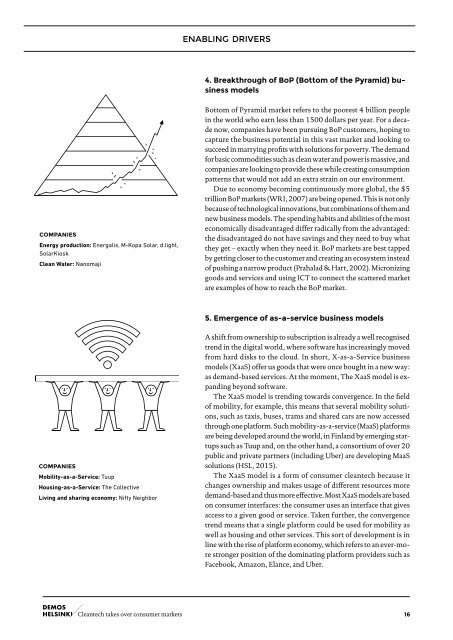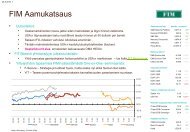Cleantech takes over consumer markets
Consumer_Cleantech_Report1
Consumer_Cleantech_Report1
- No tags were found...
You also want an ePaper? Increase the reach of your titles
YUMPU automatically turns print PDFs into web optimized ePapers that Google loves.
enabling drivers<br />
4. Breakthrough of BoP (Bottom of the Pyramid) business<br />
models<br />
COMPANIES<br />
Energy production: Energalis, M-Kopa Solar, d.light,<br />
SolarKiosk<br />
Clean Water: Nanomaji<br />
Bottom of Pyramid market refers to the poorest 4 billion people<br />
in the world who earn less than 1500 dollars per year. For a decade<br />
now, companies have been pursuing BoP customers, hoping to<br />
capture the business potential in this vast market and looking to<br />
succeed in marrying profits with solutions for p<strong>over</strong>ty. The demand<br />
for basic commodities such as clean water and power is massive, and<br />
companies are looking to provide these while creating consumption<br />
patterns that would not add an extra strain on our environment.<br />
Due to economy becoming continuously more global, the $5<br />
trillion BoP <strong>markets</strong> (WRI, 2007) are being opened. This is not only<br />
because of technological innovations, but combinations of them and<br />
new business models. The spending habits and abilities of the most<br />
economically disadvantaged differ radically from the advantaged:<br />
the disadvantaged do not have savings and they need to buy what<br />
they get – exactly when they need it. BoP <strong>markets</strong> are best tapped<br />
by getting closer to the customer and creating an ecosystem instead<br />
of pushing a narrow product (Prahalad & Hart, 2002). Micronizing<br />
goods and services and using ICT to connect the scattered market<br />
are examples of how to reach the BoP market.<br />
5. Emergence of as-a-service business models<br />
COMPANIES<br />
Mobility-as-a-Service: Tuup<br />
Housing-as-a-Service: The Collective<br />
Living and sharing economy: Nifty Neighbor<br />
A shift from ownership to subscription is already a well recognised<br />
trend in the digital world, where software has increasingly moved<br />
from hard disks to the cloud. In short, X-as-a-Service business<br />
models (XaaS) offer us goods that were once bought in a new way:<br />
as demand-based services. At the moment, The XaaS model is expanding<br />
beyond software.<br />
The XaaS model is trending towards convergence. In the field<br />
of mobility, for example, this means that several mobility solutions,<br />
such as taxis, buses, trams and shared cars are now accessed<br />
through one platform. Such mobility-as-a-service (MaaS) platforms<br />
are being developed around the world, in Finland by emerging startups<br />
such as Tuup and, on the other hand, a consortium of <strong>over</strong> 20<br />
public and private partners (including Uber) are developing MaaS<br />
solutions (HSL, 2015).<br />
The XaaS model is a form of <strong>consumer</strong> cleantech because it<br />
changes ownership and makes usage of different resources more<br />
demand-based and thus more effective. Most XaaS models are based<br />
on <strong>consumer</strong> interfaces: the <strong>consumer</strong> uses an interface that gives<br />
access to a given good or service. Taken further, the convergence<br />
trend means that a single platform could be used for mobility as<br />
well as housing and other services. This sort of development is in<br />
line with the rise of platform economy, which refers to an ever-more<br />
stronger position of the dominating platform providers such as<br />
Facebook, Amazon, Elance, and Uber.<br />
<strong>Cleantech</strong> <strong>takes</strong> <strong>over</strong> <strong>consumer</strong> <strong>markets</strong> 16






